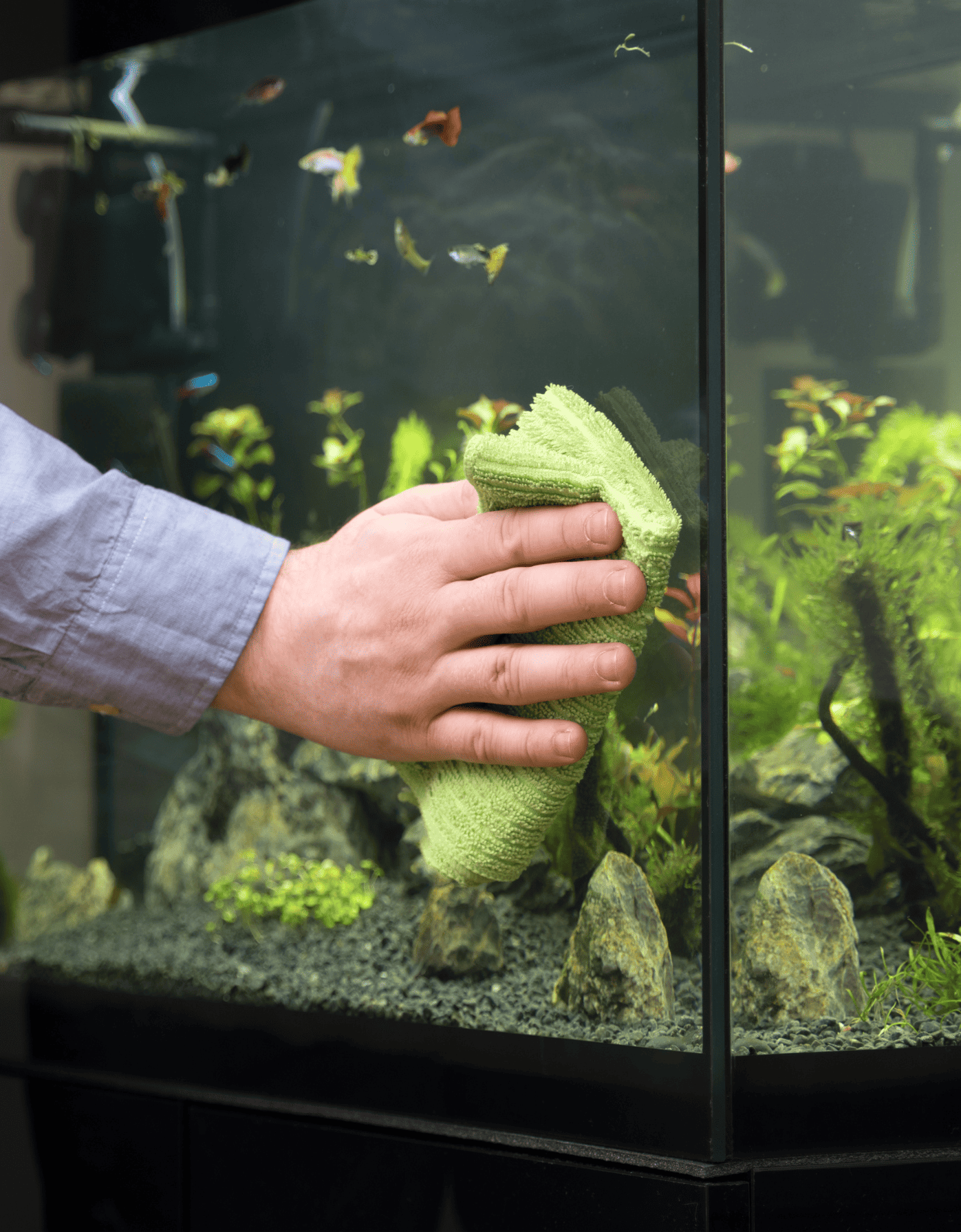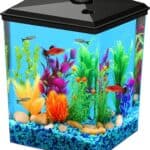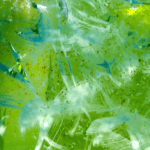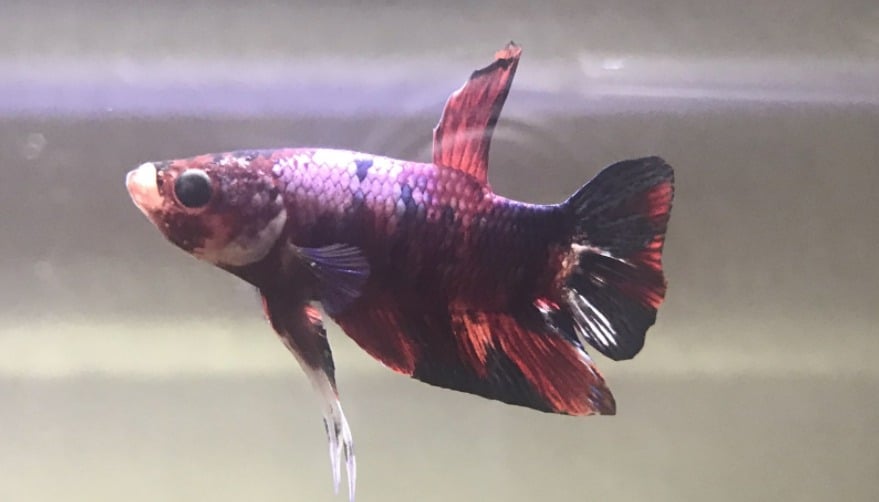Cloudiness in your fish tank can feel like a maddening mystery. However, if your underwater paradise has transformed into a foggy soup, it’s important to understand that it’s more than a mere visual nuisance.
Understanding the Causes of a Cloudy Fish Tank
Cloudiness in your fish tank is an important signal. Like a canary in a coal mine, it’s telling you that something’s off with your tank’s ecosystem.
Bacterial Bloom
This is the most common culprit for cloudiness. Picture a bustling city with an exploding population and not enough resources.
- Cause: A sudden surge in nutrients sparks a population explosion of bacteria.
- Appearance: White or gray cloudiness.
- Solution: Regular water changes and reducing feeding.
Gravel Residue
Gravel residue is like the dust that coats your furniture when you forget to clean it.
- Cause: If not thoroughly rinsed before adding to the tank, gravel can cloud the water.
- Appearance: Grayish cloudiness.
- Solution: Rinse gravel properly before adding.
Overfeeding
Overfeeding is akin to a feast that never ends, with detritus piling up in every corner.
- Cause: Uneaten food decomposes, triggering a bacterial bloom.
- Appearance: White or gray cloudiness.
- Solution: Feed fish the right amount, and clean up leftover food.
Clearing Your Cloudy Fish Tank
Just as clouds disperse after a storm, with the right steps, your fish tank can regain its clarity.
Regular Water Changes
Think of water changes as giving your fish tank a much-needed shower.
- Process: Replace 10-25% of the tank water weekly.
- Why it works: This prevents nutrient build-up, curbing bacterial blooms.
Proper Feeding Practices
Feeding your fish should be like a well-planned banquet, not an all-you-can-eat buffet.
- Process: Feed fish only what they can eat in 2-3 minutes.
- Why it works: This reduces leftover food that can decay and promote bacterial growth.
Good Tank Maintenance
Good tank maintenance is like tending a garden – it requires regular attention and care.
- Process: Regularly check water parameters and clean the tank.
- Why it works: This keeps the tank’s ecosystem balanced, preventing cloudiness.
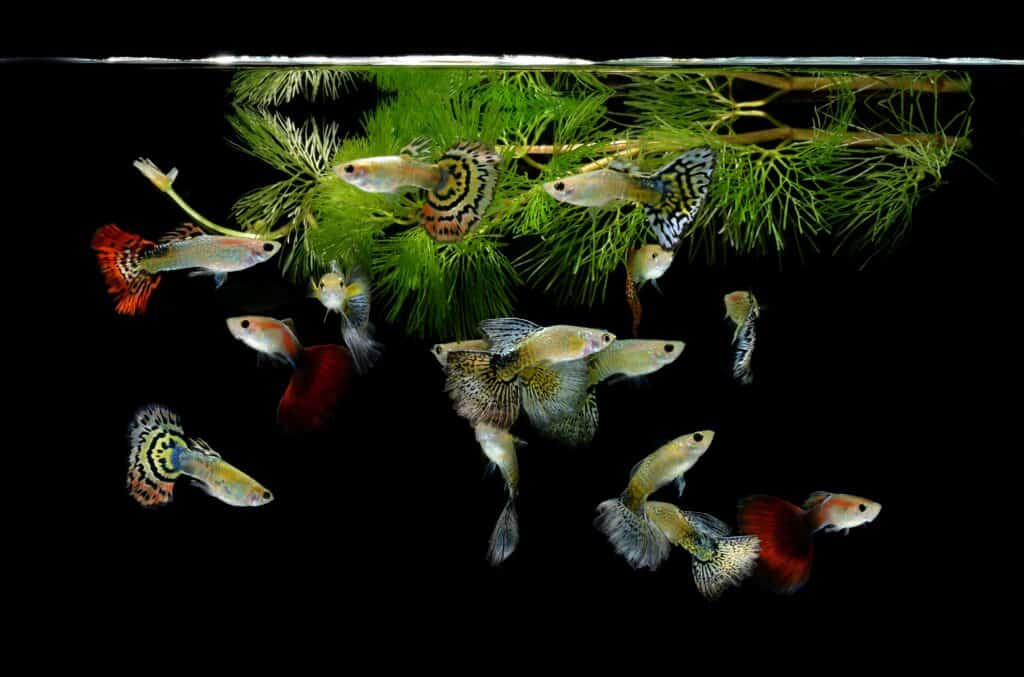
Expert Tips for a Clear Fish Tank
Here’s a table summarizing some expert tips for a crystal-clear fish tank:
| Tips | Explanation |
|---|---|
| Cycling the tank before adding fish | Establishes beneficial bacteria, preventing bacterial bloom. |
| Using a gravel vacuum | Removes detritus, preventing nutrient build-up. |
| Adding live plants | Absorbs excess nutrients, reducing chances of bacterial bloom. |
- Easy Start siphon for quick priming - starts with just a couple of pumps
- Thumb-operated flow regulator allows you to adjust speed as you clean
- Gravel guard prevents clogging ; Tube extension included for larger tanks and hard to reach areas
- Suitable for all substrates (sand, gravel, rock)
- For use in freshwater and saltwater aquariums, with a depth up to 20 in (50.8 cm)
Choosing the Right Aquarium Filter
The right aquarium filter is akin to a city’s sanitation department, tirelessly clearing out waste and pollutants.
- Process: Choose a filter rated for your tank’s size and ensure it contains a biological filtration component.
- Why it works: A good filter will efficiently remove waste, keeping water parameters stable and preventing bacterial blooms.
The Role of Aquarium Lighting
Proper aquarium lighting is like the sun in a solar system – essential, but overwhelming if unchecked.
- Process: Limit your aquarium’s light to about 8-10 hours a day.
- Why it works: Excessive light can cause algal bloom which in turn could make your water look green and cloudy.
Benefits of Tank Mates: The Clean-Up Crew
Certain aquarium inhabitants are like underwater janitors, keeping the tank clean by consuming leftover food and algae.
- Process: Consider adding scavenger species like snails, shrimp, or certain types of fish.
- Why it works: They help keep the tank clean by consuming leftovers and algae, reducing the potential for bacterial bloom.
Importance of Proper Aquarium Set-Up
Setting up your aquarium correctly is similar to laying the foundations of a house – it sets the stage for a healthy, stable environment.
- Process: Carefully layer your substrate, position your decorations, and fill with treated water before adding fish.
- Why it works: This prevents potential issues like gravel residue and ensures a safe environment for your fish.
Understanding Water Parameters
Understanding your tank’s water parameters is like understanding the weather – it helps you provide the right conditions for your fish.
- Process: Regularly test your water for pH, ammonia, nitrite, and nitrate levels.
- Why it works: Keeping these parameters in check will prevent conditions that may lead to cloudiness.
Choosing the Right Fish
Choosing the right fish is akin to choosing the right roommates – they should fit comfortably within the available space and get along with each other.
- Process: Avoid overstocking and select compatible species for your tank size.
- Why it works: Overstocking can lead to excessive waste, which may trigger a bacterial bloom and cloudiness.
The Truth About Aquarium Clarifiers
Aquarium clarifiers can be a contentious topic in the fishkeeping community. On one hand, they’re marketed as quick fixes for cloudy water. But on the other hand, they don’t necessarily address the root causes of the problem.
What are Aquarium Clarifiers?
Aquarium clarifiers are like a mop for a spill – they gather and contain the mess but don’t solve why the spill occurred in the first place. They’re chemical solutions designed to clump tiny suspended particles in your tank water, making them large enough to be trapped by your filter.
Do Aquarium Clarifiers Work?
The efficacy of clarifiers is akin to the efficiency of a vacuum cleaner on a dirty carpet – yes, they can help clean up, but they don’t prevent the carpet from getting dirty again. In other words, while clarifiers can indeed clear up cloudiness temporarily, they do not address the underlying issues causing the cloudiness.
When Should You Use a Clarifier?
Think of using a clarifier as you would a Band-Aid – it can be useful for temporary relief, but it’s not a long-term solution. If you’ve addressed the root causes (such as bacterial bloom, overfeeding, etc.) and your water is still cloudy, a clarifier can help. But remember, it’s not a substitute for good aquarium hygiene.
What are the Drawbacks of Using a Clarifier?
The main drawback of using a clarifier is that it can give a false sense of security. Like applying a fresh coat of paint on a crumbling wall, it covers up the problem without fixing it. Over-reliance on clarifiers can lead to neglect of key maintenance practices that prevent cloudiness in the first place. Moreover, some fish and beneficial bacteria may react negatively to clarifiers, so use them cautiously.
- Contains one (1) API ACCU-CLEAR Freshwater Aquarium Water Clarifier 8-Ounce Bottle
- Clears cloudy aquarium water
- Clumps floating particles into large clusters that can be easily removed by an aquarium filter
- Works fast and maximizes filter efficiency
- Use weekly and when cloudy water is observed in freshwater aquariums only
Conclusion
A cloudy fish tank, much like a misty window, obscures your view of the aquatic world. Yet, this cloudiness is more than an aesthetic issue – it’s a distress signal from your tank’s ecosystem. By pinpointing the problem, whether it’s a bacterial bloom, gravel residue, or overfeeding, you can take the necessary steps to restore clarity. Regular water changes, proper feeding, and diligent tank maintenance are your most effective tools. Remember, a clear tank is not only pleasing to the eye but also a testament to a healthy, thriving aquatic environment.
Frequently Asked Questions
Why is my newly set up fish tank cloudy?
The cloudiness in a newly set up fish tank is likely due to a bacterial bloom. It’s like a city experiencing a population boom – the bacteria are feeding on abundant nutrients in the new environment. Regular water changes and patience can help clear it up.
How long does “new tank syndrome” last?
“New tank syndrome,” akin to moving into a brand-new, unpopulated city, can last anywhere from a few days to a few weeks. It typically resolves as beneficial bacteria establish themselves and balance out the system.
How can I prevent my fish tank from becoming cloudy?
Preventing a cloudy fish tank is like maintaining a tidy home – it requires routine care and attention. Regular water changes, adequate filtration, controlled feeding, and monitoring water parameters can help maintain clear water.
Will a water clarifier clear my cloudy fish tank?
Water clarifiers can act like quick-fix bandages, aggregating tiny particles that cloud your tank so your filter can remove them. However, they’re generally not recommended as they only treat symptoms, not the underlying cause.
Is cloudy water harmful to my fish?
Cloudy water can be as harmful to fish as smog is to humans, depending on the cause. If due to a bacterial bloom or poor water parameters, it can indeed be harmful. Regular monitoring and quick response to changes are key.
How can I speed up the process of clearing a cloudy fish tank?
Speeding up the process of clearing a cloudy fish tank is akin to accelerating clean-up after a storm. Using a quality aquarium filter, maintaining proper feeding practices, and conducting regular water changes can help expedite the process.
Can I use distilled water in my fish tank to prevent cloudiness?
While using distilled water may seem like an easy fix – akin to a clean slate – it’s actually not recommended. Distilled water lacks essential minerals that fish need, and can lead to serious health issues.
